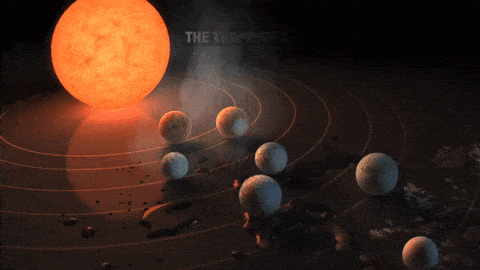
Formation of the Milky Way
Quiz
•
Science
•
8th - 12th Grade
•
Practice Problem
•
Medium
+2
Standards-aligned

Clint Sandford
Used 162+ times
FREE Resource
Enhance your content in a minute
20 questions
Show all answers
1.
MULTIPLE CHOICE QUESTION
45 sec • 1 pt

The Milky Way galaxy most likely formed
from collisions of larger galaxies.
from the big bang itself.
from collisions of smaller irregular galaxies.
from collisions of spiral galaxies.
2.
MULTIPLE CHOICE QUESTION
45 sec • 1 pt

Evidence for the Milky Way forming from collisions of smaller galaxies include
chaotic orbits of spiral arm stars.
chaotic orbits of the Sun and other disk stars.
chaotic orbits of halo stars.
variable stars in globular clusters.
3.
MULTIPLE SELECT QUESTION
1 min • 1 pt

Other evidence for Milky Way formation includes
orderly movement of disk stars.
only new star formation in the disk.
new star formation in the halo regions.
new stars in the halo region.
Tags
NGSS.MS-ESS1-2
4.
MULTIPLE CHOICE QUESTION
45 sec • 1 pt

How do the vast majority of stars orbit in the Milky Way?
in chaotic or random orbits
in orbits that are retrograde
in fixed or unchanging orbits
in mostly one direction around the central bulge
Tags
NGSS.MS-ESS1-2
5.
MULTIPLE CHOICE QUESTION
45 sec • 1 pt

How can astronomers "see" past the vast, light-obstructing dust clouds of the Milky Way?
By using the Hubble Space Telescope (HST).
By using visible light telescopes on the ground.
They make educated guesses.
By using ground-based radio telescopes.
Tags
NGSS.HS-PS4-3
6.
MULTIPLE CHOICE QUESTION
45 sec • 1 pt

What did astronomers discover about the structure of the Milky Way using radio studies?
it has many massive black holes
it has billions of stars
it has no real structure (irregular)
it has at least 5 major spiral arms
7.
MULTIPLE CHOICE QUESTION
45 sec • 1 pt

Our Sun (and solar system) lies in the _____ arm of the Milky way.
Perseus
Norma
Sagittarius
Orion
Tags
NGSS.MS-ESS1-2
Create a free account and access millions of resources
Create resources
Host any resource
Get auto-graded reports

Continue with Google

Continue with Email

Continue with Classlink

Continue with Clever
or continue with

Microsoft
%20(1).png)
Apple
Others
Already have an account?
Similar Resources on Wayground

15 questions
Weathering (Physical/Chemical) & Erosion
Quiz
•
9th Grade

20 questions
Limbah
Quiz
•
10th Grade

21 questions
BIOMOLECULES
Quiz
•
10th Grade

17 questions
2nd Summative Test
Quiz
•
12th Grade

20 questions
วาเลนไทน์สดใส ลูก พ.น ห่างไกลโควิท 19
Quiz
•
6th - 12th Grade

20 questions
Science 7 Recall
Quiz
•
7th - 8th Grade

15 questions
Science Trivia (D2S2)
Quiz
•
10th Grade

15 questions
SCIENCE 9
Quiz
•
9th Grade
Popular Resources on Wayground

5 questions
This is not a...winter edition (Drawing game)
Quiz
•
1st - 5th Grade

15 questions
4:3 Model Multiplication of Decimals by Whole Numbers
Quiz
•
5th Grade

25 questions
Multiplication Facts
Quiz
•
5th Grade

10 questions
The Best Christmas Pageant Ever Chapters 1 & 2
Quiz
•
4th Grade

12 questions
Unit 4 Review Day
Quiz
•
3rd Grade

10 questions
Identify Iconic Christmas Movie Scenes
Interactive video
•
6th - 10th Grade

20 questions
Christmas Trivia
Quiz
•
6th - 8th Grade

18 questions
Kids Christmas Trivia
Quiz
•
KG - 5th Grade
Discover more resources for Science

20 questions
Convection, Conduction, and Radiation
Quiz
•
6th - 8th Grade

10 questions
Exploring the Energy Cycle: Photosynthesis and Cellular Respiration
Interactive video
•
6th - 10th Grade

23 questions
Newton's 3 Laws of Motion
Quiz
•
8th Grade

22 questions
Rock Transformations Amplify Final Test
Quiz
•
6th - 8th Grade

37 questions
8.10B Weather Patterns
Quiz
•
8th Grade

15 questions
Domain 3 – Classification: 15-Question Assessment
Quiz
•
9th Grade

10 questions
Exploring Plate Tectonics and Their Boundaries
Interactive video
•
6th - 10th Grade

15 questions
Domain 4 – Evolution: 15-Question Assessment
Quiz
•
9th Grade



